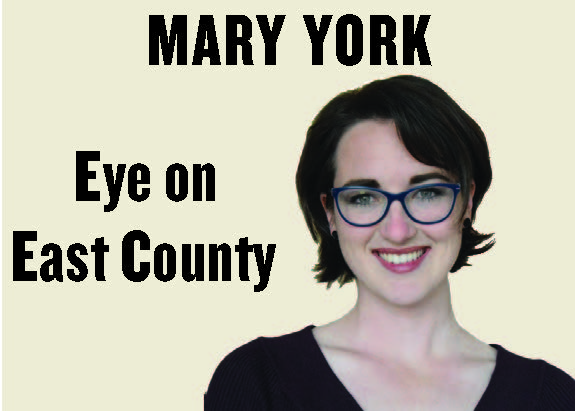Last week, we published a question on our website, Facebook page and in our newspaper – “Does East County need more affordable housing?”
I was not surprised by the answer – which was a resounding ‘no’ – as much as I was the manner in which the answer was given and the justifications that community members gave to back it.
Last week, we published a question on our website, Facebook page and in our newspaper – “Does East County need more affordable housing?”
I was not surprised by the answer – which was a resounding ‘no’ – as much as I was the manner in which the answer was given and the justifications that community members gave to back it.
In my column last week, I attempted to briefly address some of the complexities of the housing situation facing East County and the greater San Diego region. Given the reactions to The Californian’s poll question, I now realize that I left out a crucial facet of the conversation: homelessness.
Homelessness is a layered and complex problem in its own right. I am not going to attempt to address it in its entirety in this article, nor do I assume to umbrella the housing conversation here in the few paragraphs that space will allow.
But we publish every week, so there will be plenty of opportunities for this conversation to continue (and we encourage you to write to us, either letters for publication in our paper or comments in the ongoing discussions on our facebook page!).
However, for this issue to be further developed, we have to clear up some misconceptions about the homeless community.
Misconception: Homeless persons are drug and alcohol addicts.
There is a very visible faction of the homeless community who are drug addicts, alcoholics, people with years of struggle created from an unfortunate marriage of mental health issues, bad decisions and poor luck.
There is an element of personal choice at play here – some people have decided they would rather live under a bridge with a hunger in their belly than seek out help. Many decided they were beyond help a long time ago.
But the important truth is that this percentage of the homeless community is just that: a percentage. There are many, many individuals and even families who are living out of their cars or from couch to couch of their generous friends.
Will Manson, a social worker who interfaces with many in the homeless community, explained that there are a myriad of people who are technically homeless who do not fit the homeless stereotype.
“The visible homeless population we see out and about is just a small component of those who are homeless,” said Manson. “While it is not the accurate term, I tend to see that population as transient. For each visible obviously homeless person, there are many more families and individuals sleeping in cars, abandoned buildings, and garages, or receiving motels through CalWorks or another program. For me, it is unavoidable. I can’t drive down Main Street without seeing someone or a family that I know for a fact is homeless, but the average person would never know. That’s something people don’t talk about.”
It is easy to take a high-brow attitude toward homelessness, that those who are homeless are there because somehow they have made mistakes – the assumption being that we are not homeless through our own merits.
And, although there may be elements of truth in both those assumptions, it is also true that there are many who have been made homeless because their rent was raised and they can no longer afford to live in their own homes. There are college students sleeping out of the back of their cars because they cannot afford tuition and rent, even while working a job or two. There are senior citizens who are facing the streets because the neighborhood has outpriced them and they simply cannot keep up.
There is a massive shortage of affordable housing – units on which an average-income earner can maintain payments. These are not homes for ‘meth heads.’ These would be homes for hard-working families who have been priced out of the city they were born into, native East County residents, your neighbors.
Misconception: If rent is too high, people can relocate out of state.
This is a pretty idea for people who don’t have to consider it.
My father has always suggested moving out of the state to buy a house, mostly in the name of adventure and the desire to live in a place with frequent buffalo sightings, but it has never been a real possibility. We have family responsibilities in San Diego. My youngest siblings are still in school. My parents’ careers – decades in the making – are rooted in Southern California. Starting over again from scratch somewhere new, especially as both of them are in their sixties, is a ridiculous notion.
So even though San Diego is too expensive to live in, leaving is not really an option for them.
And it is not an option for thousands of families worried about how to keep a roof over their heads.
Misconception: ‘Affordable housing’ will not fix the problem.
Firstly, because I know you are all thinking it, let us acknowledge that the question of what constitutes ‘affordable housing’ is complex. For the sake of this conversation, let us summarize it by assuming that affordable housing is a unit that can be reasonably paid for by someone earning only $30,000 a year – that’s a minimum wage salary.
If someone cannot afford to rent some form of permanent shelter on minimum wage, the problem is with the system, not with them.
According to Manson, more available housing – that is, housing within the financial reach of low and average income earners – would do a great deal to alieve the struggles of the homeless community.
“Very simply, lack of housing – that is the single most difficult thing that we encounter working with the homeless,” he said. “Drug abuse, mental health, the job market are all important, but available housing is the number one issue. The deck is stacked against people trying to get on their feet or back on their feet. We spend so much time as social workers working to fix the various ‘barriers’ to housing, only to get stonewalled at the very end when nothing is available and affordable.”
Now we need to tackle an even touchier subject: the community’s responsibility to take care of the least of its members.
East County is by no means Beverly Hills. However, there is a certain amount of comfort afforded many of its residents that lies in striking contrast to the meager provisions of East County families and individuals who find themselves in hard times.
The easiest approaches are simple: shift responsibility for care and protection of these individuals onto the government. Start another grant. Create another program. Complain between every election cycle.
Similarly, we could ignore the problem as a whole, focusing only on the facet of the homeless community that is constantly in our collective faces, sleeping under bridges and in parks, leaving trash in the streets, and wandering our communities listlessly, a walking reminder that, unlike them, many of us have been spared the very real consequences of bad decisions.
The loud, unstable part of the homeless community makes it easy for us to disregard the homeless population as a whole.
Neither group should be ignored.
“Don’t get me wrong,” Manson said. “There needs to be more investment in mental health services and drug/alcohol treatment, but housing is the biggest issue we face.”
So, how valid is the argument: Not in my backyard? Does the government have the right to insist on better housing if the community does not embrace productive change on their own? Should we take some of East County’s wide open spaces and develop them, targeting the low-income population who needs shelter most? Should we refurbish underused industrial neighborhoods, rezone and rebuild to create affordable neighborhoods? Should we re-examine our cities’ infrastructure to start developing a long-term plan to accommodate expanding population?
I will not be answering any of those questions in this article – I would not pretend to be able to without first standing in your shoes, for the span of your lifetimes, with your own lives and experiences in East County to weigh in on the decision.
No, these questions are for you to answer. And, hopefully, with broadened understanding of the issues, the answers will become clearer for all of us.













